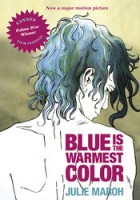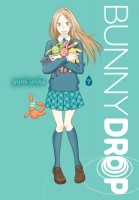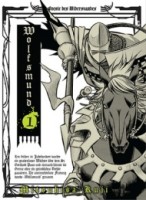My News and Reviews
I only posted one review last week, but that wasn’t the only thing going on at Experiments in Manga. The review was for Yoshikazu Yasuhiko’s Mobile Suit Gundam: The Origin, Volume 2: Garma. The third volume is scheduled to be released later this month and I realized that I hadn’t reviewed the second one yet. If you enjoy science fiction manga the series is definitely worth checking out, even if you’re not a Gundam fan. What else was going on at Experiments in Manga? I posted August’s Bookshelf Overload for those interested in the absurd amounts of manga I manage to collect. My most recent manga giveaway is currently in progress as well; there’s still time to enter for a chance to win the first Blood Lad omnibus. Since Experiments in Manga is now part of the Manga Bookshelf team, I’ve also started to participate in some of the group features: Pick of the Week and Manga the Week of.
Elsewhere online, Dan Kanemitsu wrote an opinion piece for CBLDF about the recent ban of Keiji Nakazawa’s Barefoot Gen manga in Japan—The Inconvenience of Barefoot Gen. Happily, the ban has since been lifted. (In the past I reviewed both the first volume of Barefoot Gen and Nakazawa’s autobiography for the Barefoot Gen Manga Moveable Feast.) Sean Kleefeld at Kleefeld on Comics has put together some pie charts based on Alex Woolfson’s survey of the readers of his Young Protectors comic—Who Reads Yaoi Webcomics?. I found the results and demographics to be very interesting. Finally, Ng Suat Tong posted Island of Sex, Panorama of Empire at The Hooded Utilitarian, an in-depth analysis of Suehiro’s Maruo’s The Strange Tale of Panorama Island manga and Edogawa Rampo’s original novella. (In the past, I reviewed the manga and the novella separately.)
Quick Takes
 Blue Is the Warmest Color by Julie Maroh. Originally published in French in 2010, Blue Is the Warmest Color has only recently been released in English. The graphic novel has won several awards as has its film adaptation. It’s a beautiful comic and a beautiful love story. Maroh’s artwork is wonderful. I particularly liked her use of color; much of the graphic novel is illustrated with muted tones with blue as an accent color.Clementine is in high school when she completely falls for Emma. She must come to terms with her identity and sexuality—something that is at first difficult for her to fully embrace and something even more difficult for many of her friends and her family to accept. Although the ultimate ending of Clementine and Emma’s story is known from the very beginning of Blue Is the Warmest Color, Clementine’s death still seems to come rather suddenly. Blue Is the Warmest Color is tragic and bittersweet, but it is also a lyrical exploration of love and desire.
Blue Is the Warmest Color by Julie Maroh. Originally published in French in 2010, Blue Is the Warmest Color has only recently been released in English. The graphic novel has won several awards as has its film adaptation. It’s a beautiful comic and a beautiful love story. Maroh’s artwork is wonderful. I particularly liked her use of color; much of the graphic novel is illustrated with muted tones with blue as an accent color.Clementine is in high school when she completely falls for Emma. She must come to terms with her identity and sexuality—something that is at first difficult for her to fully embrace and something even more difficult for many of her friends and her family to accept. Although the ultimate ending of Clementine and Emma’s story is known from the very beginning of Blue Is the Warmest Color, Clementine’s death still seems to come rather suddenly. Blue Is the Warmest Color is tragic and bittersweet, but it is also a lyrical exploration of love and desire.
 Bunny Drop, Volumes 7-9 by Yumi Unita. Parts of Bunny Drop were spoiled for me early on but I wanted to see how things played out and how Unita handled it all. These volumes actually do a great job showing Rin’s developing relationship with her mother as well as her struggle with her feelings for Daikichi and his response to them. But then along comes a huge plot reveal in the fifty-fourth chapter that attempts to smooth everything over and make it okay. (Honestly, I was kind of pissed off about it.) It’s as though Unita was trying to find an easy way out after backing herself into a corner. Unfortunately it doesn’t really work, contradicts earlier parts of the story, and even negates previous character developments. In part due to poor planning, the twist is neither satisfying nor believable. Perhaps if Unita had taken the time to show the intervening two years and how Daikichi’s feelings evolved it would have been more convincing. Even though I found the ending of Bunny Drop to be disappointing, I still plan on picking up the final volume of short stories.
Bunny Drop, Volumes 7-9 by Yumi Unita. Parts of Bunny Drop were spoiled for me early on but I wanted to see how things played out and how Unita handled it all. These volumes actually do a great job showing Rin’s developing relationship with her mother as well as her struggle with her feelings for Daikichi and his response to them. But then along comes a huge plot reveal in the fifty-fourth chapter that attempts to smooth everything over and make it okay. (Honestly, I was kind of pissed off about it.) It’s as though Unita was trying to find an easy way out after backing herself into a corner. Unfortunately it doesn’t really work, contradicts earlier parts of the story, and even negates previous character developments. In part due to poor planning, the twist is neither satisfying nor believable. Perhaps if Unita had taken the time to show the intervening two years and how Daikichi’s feelings evolved it would have been more convincing. Even though I found the ending of Bunny Drop to be disappointing, I still plan on picking up the final volume of short stories.
 Sankarea: Undying Love, Volume 2 by Mitsuru Hattori. I’m a little surprised by how much I’m liking Sankarea. At least I can say that I enjoyed the second volume more than the first. I even chuckled out loud a few times while reading it. I hope the series continues to improve. At this point Sankarea is definitely more of a romantic comedy than it is a horror story. The horror elements are still there though, as are the nods to zombies in popular culture. But it’s Rea’s father who remains the creepiest part of the series. In one delightful scene, Chihiro even calls him out on it directly to his face. And even though Sankarea is a comedy, I’m glad to see that Danichiro’s disturbingly unhealthy relationship and obsession with his daughter isn’t seen as funny. On the other hand, Rea’s relationship with Chihiro—as weird as it is and as weird as they both are as individuals—is almost charming. Sankarea is kind of a strange series, but then so are hydrangea zombies.
Sankarea: Undying Love, Volume 2 by Mitsuru Hattori. I’m a little surprised by how much I’m liking Sankarea. At least I can say that I enjoyed the second volume more than the first. I even chuckled out loud a few times while reading it. I hope the series continues to improve. At this point Sankarea is definitely more of a romantic comedy than it is a horror story. The horror elements are still there though, as are the nods to zombies in popular culture. But it’s Rea’s father who remains the creepiest part of the series. In one delightful scene, Chihiro even calls him out on it directly to his face. And even though Sankarea is a comedy, I’m glad to see that Danichiro’s disturbingly unhealthy relationship and obsession with his daughter isn’t seen as funny. On the other hand, Rea’s relationship with Chihiro—as weird as it is and as weird as they both are as individuals—is almost charming. Sankarea is kind of a strange series, but then so are hydrangea zombies.
 Wolfsmund, Volume 1 by Mitsuhisa Kuji. Very few historical manga with a European setting have been licensed in English, and so I was intrigued by Vertical’s acquisition of Wolfsmund. I was even more interested when I learned that Kuji was once an assistant for both Kentaro Miura and Kaoru Mori, whose work I love. (I particularly noticed Mori’s influence in how Kuji draws many of the character’s eyes in Wolfsmund.) Wolfsmund takes place in 14th-century Switzerland and is a retelling of sorts of the legend of William Tell. So far the story has focused on those attempting to illicitly cross through the Sankt Gotthard Pass, generally unsuccessfully but not without putting up a fight. While Wolfsmund isn’t overly graphic—most of the gorier moments are implied rather than actually seen—it is a violent and brutal manga. Very dark and very intriguing, I’m looking forward to the next volume of Wolfsmund a great deal.
Wolfsmund, Volume 1 by Mitsuhisa Kuji. Very few historical manga with a European setting have been licensed in English, and so I was intrigued by Vertical’s acquisition of Wolfsmund. I was even more interested when I learned that Kuji was once an assistant for both Kentaro Miura and Kaoru Mori, whose work I love. (I particularly noticed Mori’s influence in how Kuji draws many of the character’s eyes in Wolfsmund.) Wolfsmund takes place in 14th-century Switzerland and is a retelling of sorts of the legend of William Tell. So far the story has focused on those attempting to illicitly cross through the Sankt Gotthard Pass, generally unsuccessfully but not without putting up a fight. While Wolfsmund isn’t overly graphic—most of the gorier moments are implied rather than actually seen—it is a violent and brutal manga. Very dark and very intriguing, I’m looking forward to the next volume of Wolfsmund a great deal.

Speak Your Mind